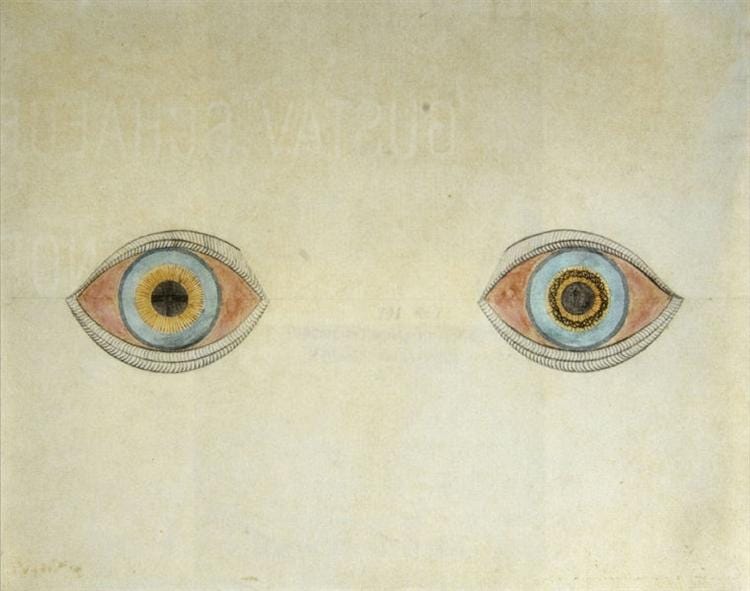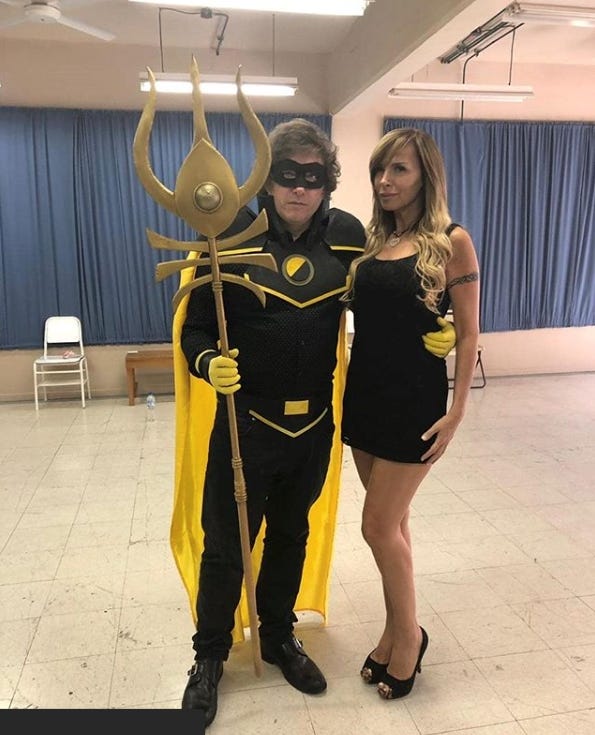On the Mars Cazimi in Scorpio: "Old Death"
I explore the recent Mars cazimi in Scorpio's seeding of monsters and its echoes of the last such cazimi in November of 1991.
“If in some smothering dreams, you too could pace
Behind the wagon that we flung him in,
And watch the white eyes writhing in his face,
His hanging face, like a devil’s sick of sin;
If you could hear, at every jolt, the blood
Come gargling from the froth-corrupted lungs,
Obscene as cancer, bitter as the cud
Of vile, incurable sores on innocent tongues,—
My friend, you would not tell with such high zest
To children ardent for some desperate glory,
The old Lie: Dulce et decorum est
Pro patria mori.”
— from “Dulce et Decorum Est” by Wilfred Owen (1921)
For the first time in more than thirty years, the Sun and Mars met in a Cazimi in the sign of Scorpio on November 17th — the subterranean grotto where Ares is empowered, though its missions tend to be more cloak-and-dagger in its water domicile.
Traditionally, cazimis are auspicious moments when a planet is granted the opportunity to slip through a trick door into the throne room of our cosmic luminary. From the Arabic, “as if in the heart of the Sun”, they represent a reset button in the synodic dance between the solar seat of authority and its starry court wanderers. Leading up to this moment of revelation and renewal, however, the planet is degraded, scorched, its vital powers diminished. I quoted Wilfred Owen’s bitter cri-de-coeur against the senseless bloodshed of war above, as this threshold does indeed feel like “vile, incurable sores on innocent tongues”.
Though William Lily describes a planet’s condition at cazimi as “wondrous strong”, ancient Persian astrologer Abu Ma’shar is more tentative. He describes the cazimi moment as an act of purification when the planet is all but drained of its strength — but will regain health afterwards.
That “as if” haunts me. Mars’ path out of the throne room will be treacherous indeed. The first two hostages were released during Mercury’s past cazimi in Libra. As I write this, Israel and Hamas appear to be edging toward a deal that would see the release of a larger number of hostages, in return for a limited ceasefire and the freeing of Palestinians from Israeli jails. Of course, the idea of putting a genocide briefly “on ice” is deeply abhorrent on so many levels…
Within that solar cupola, any battles falsey waged became painfully clear. As the Sun pierces through even the thickest fogs of war, Mars is brought to such a harrowing point of no return that he has no other choice but to fall to his knees. To accept that the old mission has expired. The world the original battle lines were drawn in no longer exists. And to continue blithely on with Martial business of usual will hasten some sort of soul death. Or centuries more of generational trauma.
I’ve also been thinking about the ancient handmaidens of Ares, the Keres, who sucked the blood from the sand of those fallen in combat. Unable to actually kill, all these death demons could do was to wait, hovering over the battlefield in their ominous holding patterns, to feast on the dead. “And when they had satisfied their hearts with human blood, they would throw that one behind them and rush back again into the battle and the tumult.” The consumption of the endlessly streaming spectacle of war by humans as well as AI, alongside other dopamine harvesting media, perhaps makes all of us accomplices of Ares, whether we have the stomach to accept this or not.
Mars’ cazimi also trines Neptune in Pisces — our cosmic river of Lethe, erasing memories as the God of War is born again. This threshold feels less than decisive and more like a fever dream. I’ve been trauma-bonding with my boyfriend as we watch the deeply uncomfortable The Curse together, a truly Scorpionic collaboration between Nathan Fielder and Benny Safide that captures the cracks forming in the glittering surfaces of woke delusion, gentrification, and climate change individualism — and then plunges deeper still into more Lynchian psycho-sexual and micro-penal horrors. If you want to understand the murkiness of Mars and Neptune crossing swords, The Curse is required (masochistic) viewing.
The decisive victory today by far-right Argentinian Javier Milei, “El Loco”, is another hint at the high weirdness this cazimi portal is ushering us into. The libertarian, anarcho-capitalist, and climate-change denier who considers his dogs his primary political strategists. For real though. His deceased English mastiff, Conan, apparently prophesied Melei’s god-given mission to be president in a telepathic conversation with a medium. Milei would go on to pay 50,000 dollars to have Conan cloned, which resulted in five new Conans that he now considers his closest advisors. Milei believes that he and the OG Conan knew each other in a past life as a lion and gladiator in the Roman colosseum, when the two decided not to slaughter each other and to instead join forces again in the future. Just to give you an idea of how fucking bonkers this new Martian epoch will likely be.
And we now have an entire generation of Zoomers who do not have any living memory of September 11th. The day the cazimi was exact, it opposed Osama Bin Laden’s Mars in Taurus. Over the course of 24 hours, the Saudi born founder of Al-qaeda went viral on TikTok as his “Letter to America” (dropping the mic on Israel’s violent settler occupation of Palestine between a madman’s ramblings of endless war) had Zoomers saying “he’s just like me fr”. Until he was swiftly decried again as a Nepo-baby. Virality in 2023 is a cruel mistress indeed.
I was struck by the similarity between Kurt Cobain and Bin Laden’s charts (Pisces Sun/Mercury/Venus and Cancer Moons), reminding me of this ominous feeling I had about the lack of a credible artistic renaissance during these murky Saturn in Pisces years. Gen X had Cobain (and a cadre of other grunge artists) and now the zoomers have a terrorist who spent his final days gooning porn and disney movies in his fortified cave.
To be fair, the virality of the letter in question feels very Mars in Scorpio psyop. This is a crucial “masks off” moment when normies are finally seeing the US war machine for what it is, across party lines. Heating Tiktok videos that paint zoomers as a Hamas-loving death cult — rather than rightly horrified by the state-sanctioned carpet bombing of children — feels like a deliberate muddying of the waters as massive protests demanding a ceasefire continue to shut down Western business as usual. In any case, Geno-Joe’s solar return dawning in the ashes of this cazimi is feeling very doddering and low-energy antichrist indeed.
The last time we experienced a Mars cazimi in Scorpio, on November 8th 1991, the Soviet Union’s KGB ceased all operations. At least on paper:
“Indeed, after the hammer-and-sickle flag on the Kremlin was replaced by the tricolor of the Russian Federation that nation's first president, Boris Yeltsin, dismantled the agency and dispersed its functions among various other parts of the new government. In reality, though, intelligence experts say the KGB never really went away. Instead, like spies often do, it simply has resurfaced with a different name, FSB, whose letters stand in Russian for Federal Security Service. And today, with a former KGB agent and FSB head named Vladimir Putinas the head of state, the organization once known as the KGB seems to have regained much of its old reach and power.”
When the Mars cazimi hits the reset button in Scorpio, it signals less of a decisive end to the battle and more of a mutation. The cazimi ushered in another ambiguous end to a period of global conflict, whose Hydra heads would not be severed for long. The last of the oil fires in Kuwait, set alight by retreating Iraqi troops, were extinguished just days before Mars’ cazimi on November 8th. Though the Gulf War officially ended in February of 1991, the Iraqi “scorched earth policy” dragged on for months. It’s hard not to think of the Scorpion fatally wounding itself in its last desperate death blow. Richa Syal writes on the environmental disaster’s toxic half-lives:
“But as Iraqi forces pulled out, in a final vengeful act they deliberately set more than 700 oilwells ablaze. Three decades later, despite promise after promise, Kuwait is still scarred by catastrophic damage from what is regarded by some as one of the world’s worst environmental catastrophes – and the billions set aside for remediation are still waiting to be spent.
“The sound of gushing oil and roaring fires is still in my memory,” remembers Dr Samira Omar Asem… “I remember seeing a dead goat sinking in an oil lake.”
The oilwells burned uncontrollably. The smoke plume above them initially stretched for 800 miles. A staggering 11m barrels of crude oil poured into the Persian Gulf, creating a slick nine miles long. Nearly 300 oil lakes formed on the surface of the desert, polluting the soils.
An international coalition of firefighters battled the fires for months until the last well was finally capped on 6 November 1991 and Kuwait celebrated under clear skies.”
30 years on, Kuwait is still scarred by this catastrophic pollution, as rare diseases bloom decades later in those exposed to the toxic smoke. And of course a former KGB agent continues to wage a slow and self-destructive war. This is all a reminder that Mars cazimis in Scorpio seem to bestow the most pyrrhic of victories — and create many more monsters than they vanquish.
In the aftering of the Mars’ audience with Sol, I’ve been revisiting the Homeric hymn for Mars, one of the shortest in the “songs of praise” dedicated to a particular deity and composed in the same dactylic hexameter as The Iliad. Though the hymn opens stridently, with the spear thrusts of a list of peacocking epithets — “chariot rider” “golden helmed” “harnessed in bronze” — a more measured tone is swiftly introduced, as if to temper red-hot Martial steel.
Rather than venerating Mars’ penchant for war and bloodshed, the hymn lauds the God of strife as the “savior of cities” rather than a destroyer. He’s described as the defender of Olympus and the ally of Themis (the archetype of order and justice). The poem invokes Ares as a god of discipline: a “stern governor of the rebellious.” He is called upon to “crush down the deceitful impulses” of the soul and to “restrain also the keen fury of my heart which provokes me”.
Like Benjamin Franklin's advice to “be at war with your vices, and at peace with your neighbors”, the true Martian battle is an internal one. The “boldness” of Ares that the hymn praises is having the power of endless fiery spears and blazing steeds but choosing to “abide within the harmless laws of peace” instead. Of course we do well to remember Mars’ exaltation in the sign of Capricorn, a sign of prudence, caution, and above all — patience.
If there have been any unambiguously glad cazimi tidings, it would be the drop of three new tracks from Charles Bissell’s new project Car Colors — the frontman from the now disbanded The Wrens. 2003’s Meadowlands is probably in my top ten albums of all time, its 13 tracks emblazoned on my limbic system — an old companion through many a heartbreak and guttural weep in the tub. I discover new dimensions to its songs with every turn my life takes. The opening track of Meadowlands unfurls a litany of loss against a static of crickets, concluding with the line “I can’t believe / what’s life done to me” — somehow striking a note of wonder rather than resignation. Indeed, the slow burn is something Mars in Scorpio does very well and what a delight to have these new tracks emerge 20 years later, battered by life’s hammers and tongs and Bissell’s own battle with cancer — gleaming. Or in Bissell’s own words:
“Old Death” is, like the rest of the album, sort of a sequel to the meadowlands before it and like that one, is about time, how one chooses to spend it, what those choices cost. That means for me, the song (and album) is also about making the album itself. It’s about death, maybe obviously, but it’s really about my dumb life…
[It] serves both as the album-in-miniature – literally, most of its six-or-so non-repeating sections sorta correspond to other songs on the album – and as a pretty good example of how&why the album as a whole was put together over 10 years of solo work. In one sense, that’s sorta just practical, work-like, even architectural – rooms are added, hallways extended, windows bricked over, additions torn down, entrances and exits opened, rooms painted, paint scraped away, re-painted…until it feels livable.”
You can listen to all three singles here. xoxo







I've never heard of Meadowlands. Great piece. Glad you're back here on Substack!